This pot is a cookware chimera of saucepan and stewpot.

- Type: Tin-lined stewpot in hammered finish with brass handles fastened with three copper rivets; fitted lid with knob and ring handles
- French description: Bassine à ragoût étamé et martelé avec anses en laiton munies de trois rivets en cuivre; couvercle emboîté avec bouton et anneau
- Dimensions: 26cm diameter by 12.5cm tall (10.2 inches by 4.9 inches)
- Thickness: 1.8mm at rim
- Weight: 2720g (6 lbs) without lid; 3460g (7.6 lbs) with lid
- Stampings: Gaillard Paris (large arch style)
- Maker and age estimate: Gaillard; 1940s-1960s
- Source: treasures-from-france (eBay)
[NOTE: This is one of my pots that I bought from an unethical eBay seller who placed what appears to be a forged Gaillard stamp on it. Part of the evidence of this forgery is that the forged stamp — a copy of a real Gaillard stamp from the 1930s-1940s — does not match the antique construction of this pan. I did not know this when I bought it and wrote it up here. I am preserving this post in its original form to document my foolish credulity and my efforts to make sense of this fraud.]
The brass ring on the lid is what first drew my eye to this pot. I see ring handles — in French, anneaux — on shallow pans like gratins that can be hung flush on the wall. I’ve never seen one on a round lid like this.

I took it as a clue that there’s something unusual about this pot, but it wasn’t until I had it and could examine it closely that I realized the extent of it: this pot started out as a saucepan with a lollipop lid and was subsequently converted to a stewpot with a knob lid. Take a look at the interior rivets — one side has two extra holes.
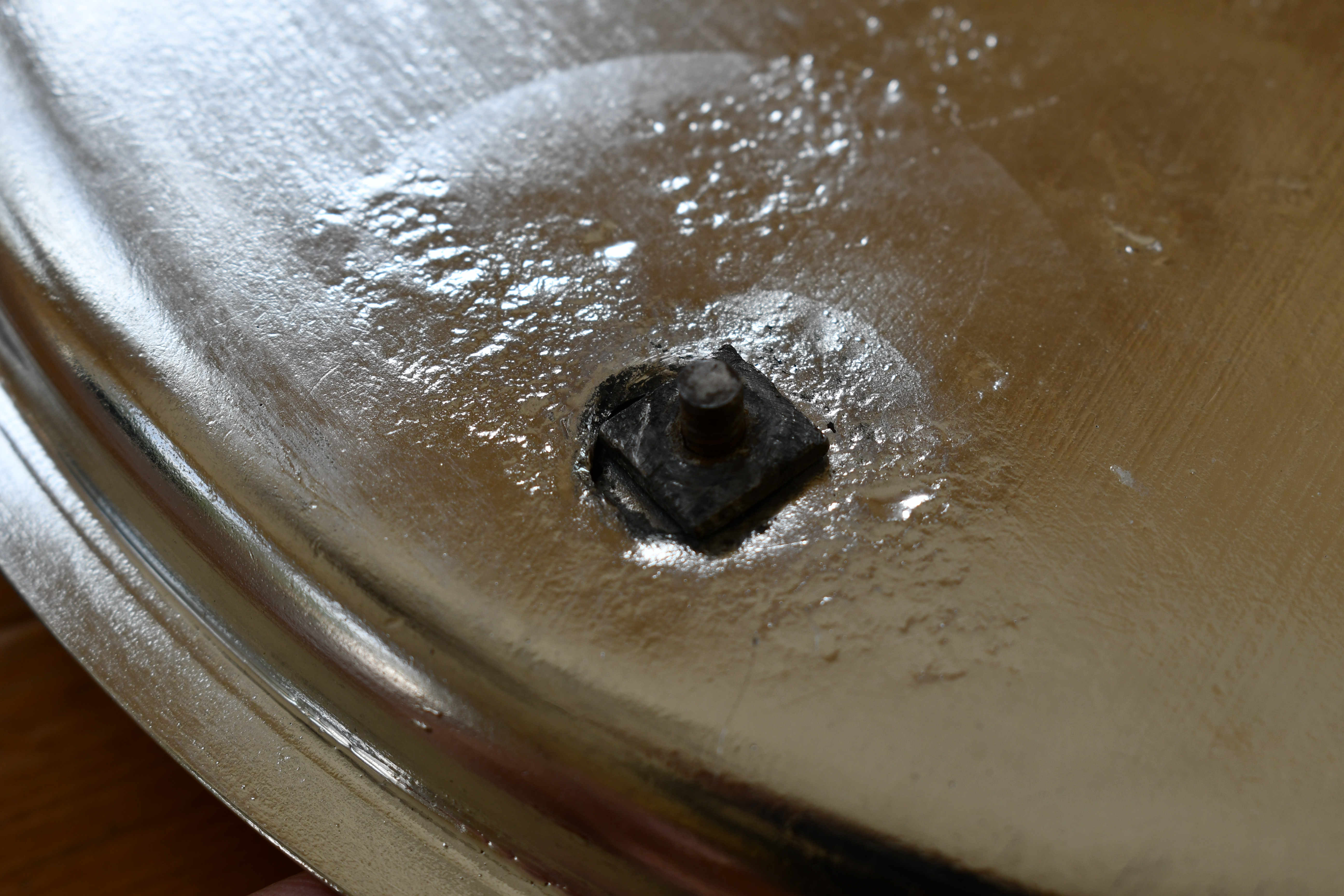
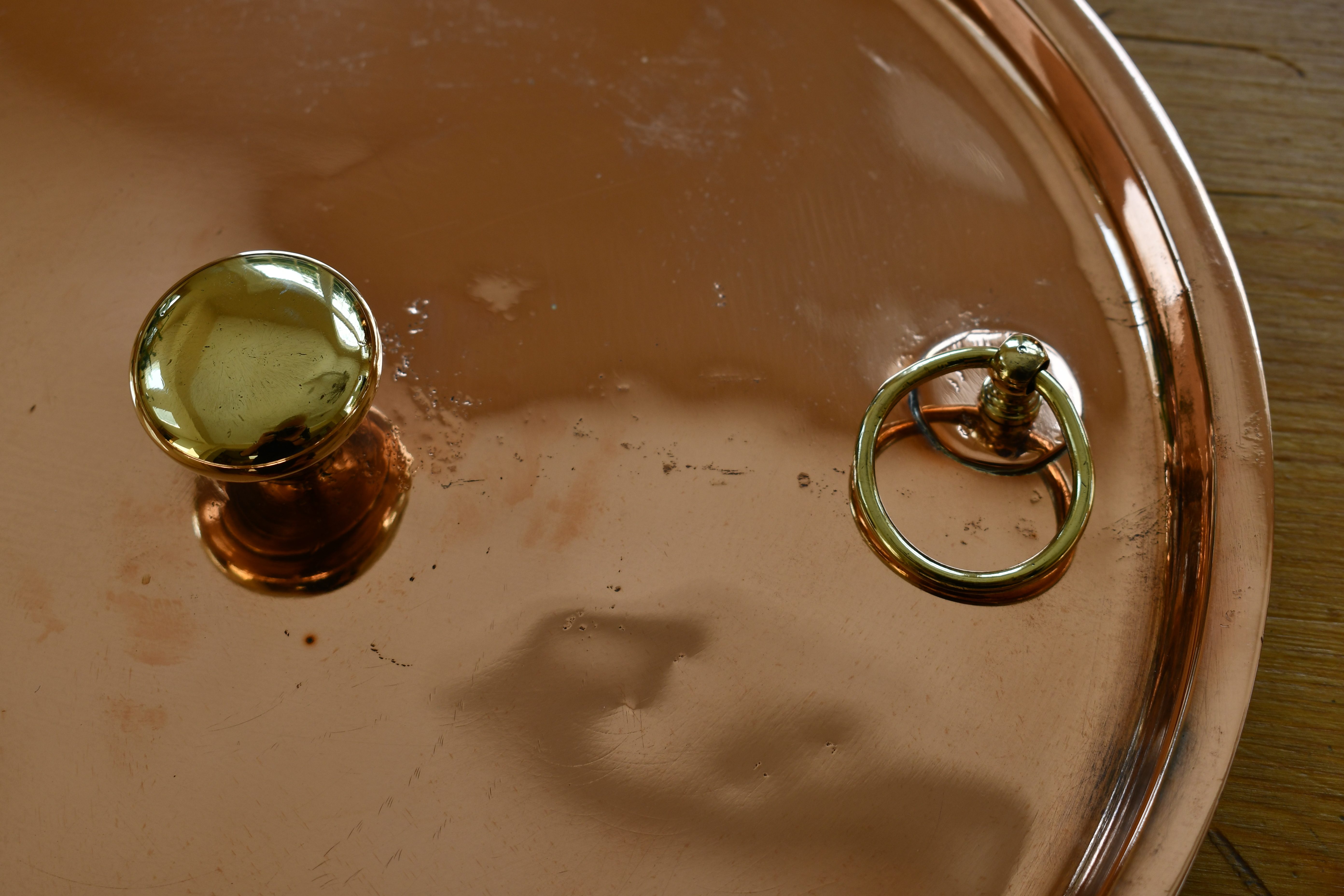
You can see those extra holes just peeking out under the handle baseplate on that side. They’ve been filled in neatly with what I presume are disks of copper. The work is beautiful — the handles are gorgeous cast metal, a very reddish brass. (I am entertaining the idea that the handles are actually copper, but I have not made up my mind about this, so for the moment I am calling them brass.)
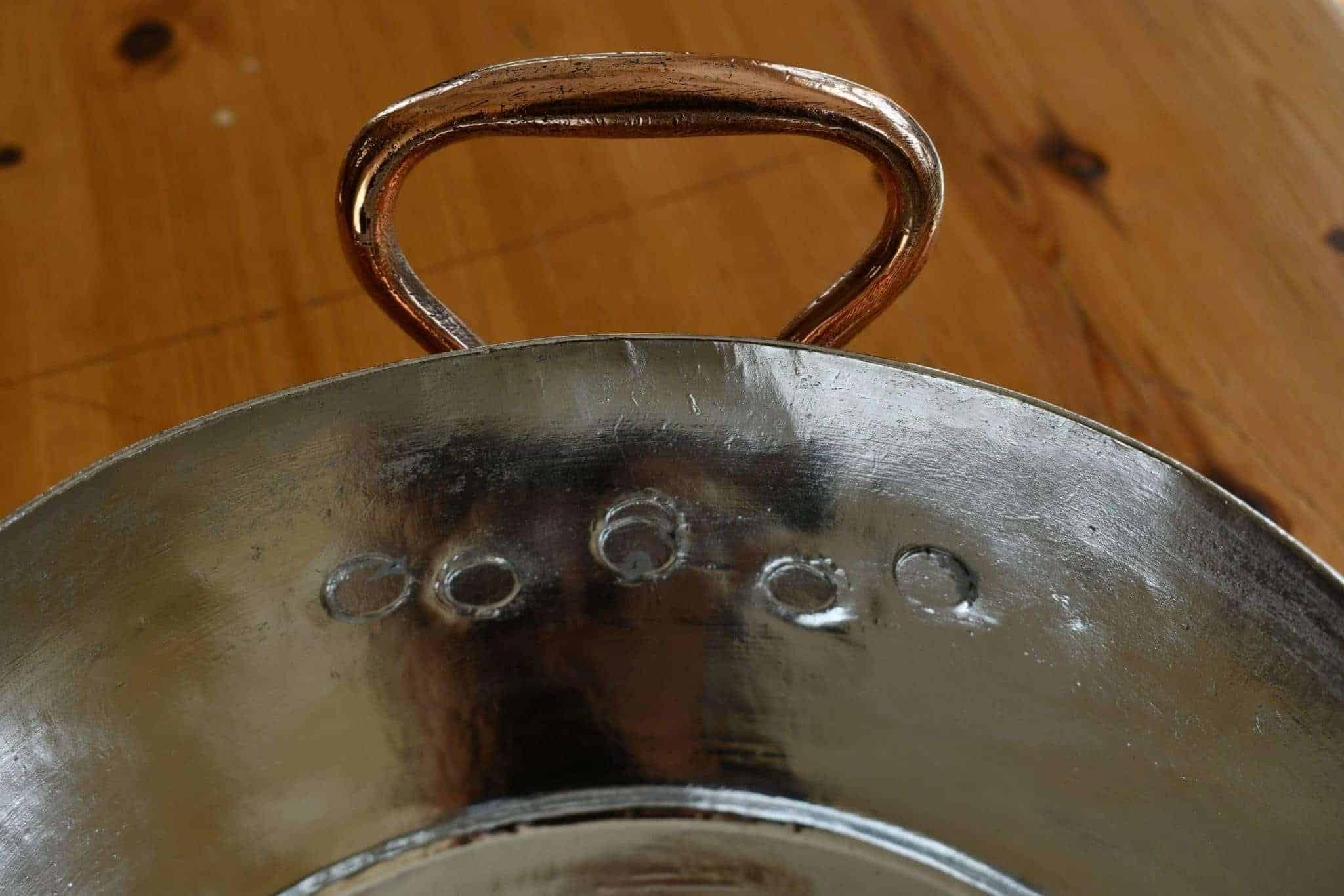
The close-set triangular arrangement of holes matches the pattern for a cast iron handle. At some point that handle was removed and replaced with a handgrip; the center hole took the central rivet for the new handle, two additional holes were cut for the wider-set side rivets, and the superfluous lower holes were filled in.
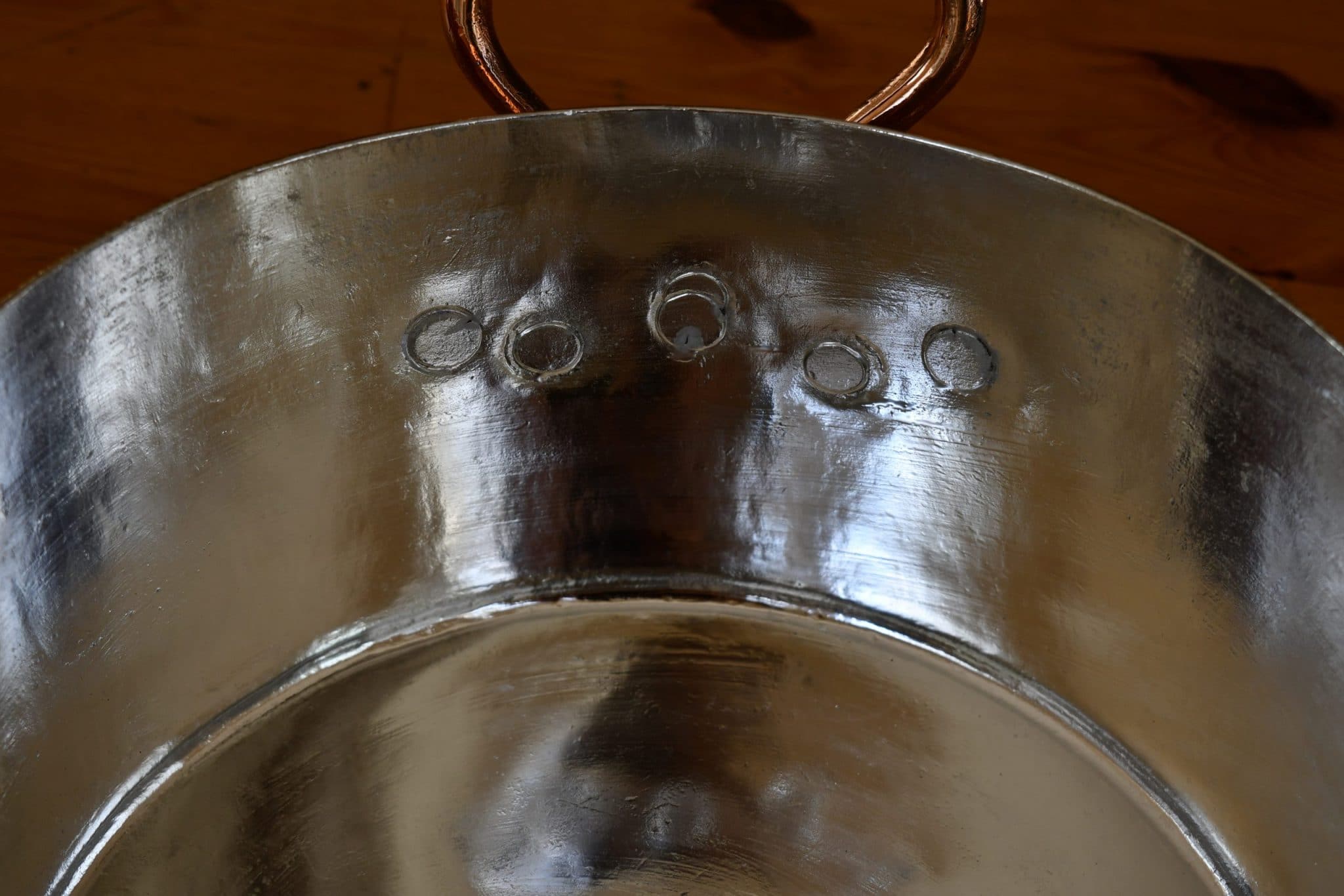
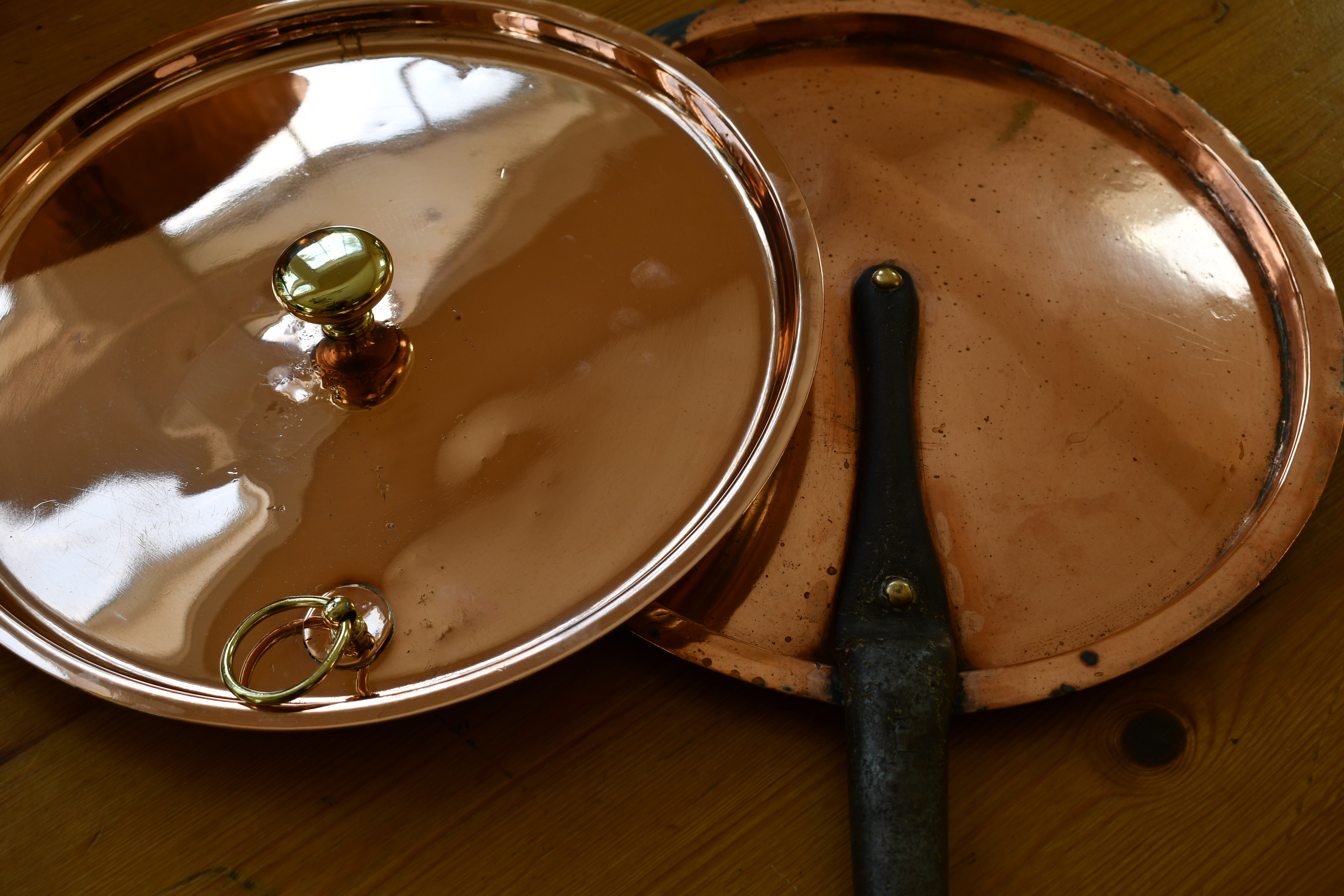
This transformation also explains the second ring handle on the lid. I think it was created as a lollipop-style lid with a projecting stick handle, as would be appropriate for a saucepan. When the body of the pot was transformed into a stewpot, the lid was also reconfigured. The iron handle was removed, the central hole was fitted with a button knob and the second hole close to the edge became the mounting for the ring. The photos below show this pot’s ring-handled lid next to a 26cm lollipop-style lid with a projecting iron handle — you can see the same arrangement of rivet holes.


Erik Undiks at Rocky Mountain Retinning restored this pan for me and he did some skillful repair work. In order to retin the lid he needed to remove both the knob and the ring, and he reported that the brass fitting around the ring base was sadly deteriorated. He replaced it with a neat disk of copper. The photos below show the original fitting and Erik’s repair work.


I am quite curious about this chimera, not least because I’m getting some mixed messages about when it was made.
First, of course, I see the dot, which is the pinprick mark in the center of the base left by the point of a compass to mark the circular blank for the pot. This hand-cutting became unnecessary when powered machinery could punch out symmetrical blanks from sheet metal. When I see the dot, my immediate assumption is that the pot was made in the 19th century up to the very early 20th century.


But then there is the stamp. In my experience, Gaillard stamps from the 1880s until the 1930s are full-name stamps for J. Gaillard, J. & E. Gaillard, et cetera. I believe this version of the stamp appeared towards the middle of the 20th century. To see a dot on a pot with this stamp is an anachronism.
[NOTE: It’s an anachronism because this stamp is a forgery. I did not know this when I wrote this post and you can see how hard I had to contort myself to make sense of it. Sigh.]

So how did a late 19th century (plus or minus) saucepan end up with two new handles and a post-war stamp? I don’t know the specifics of this pot’s history but, as usual, I am free to speculate. My working theory for this pot is that it was manufactured sometime between 1890 and 1910 as a saucepan. It’s possible that Gaillard made it but I can’t be certain as the original handles are not present and there’s no contemporaneous Gaillard stamp. Sometime after that, perhaps during the 1920s to the 1940s or so, the pan was reconfigured as a stewpot and given the 20th century Gaillard stamp. (There is no Made in France stamp, so this was pre-1957.)
But why go through the trouble of repurposing an existing pot? My guess is that copper pots were precious enough during this period of time that it was easier to rework it rather than acquiring a new one. A study of historical copper prices describes shortages during the first World War (1914-1918), followed by a market slump. Copper prices rose again at the outbreak of the second World War (1939) and scarcity continued through the Korean War (1950-1953). I see a connection between these macroeconomic forces and the production of copper cookware in Europe: when copper prices were high, it would be challenging to source it and sell the pots at a reasonable price. (For example, it was in the 1940s and 1950s that Mauviel began producing aluminum pots and pans because copper was simply too expensive.) The addition of a later Gaillard stamp implies that the pot was marked for retail — perhaps it was old unsold stock, or salvaged.
But I can only guess as to why the pot was reconfigured from a single-handled saucepan to a double-handled stewpot. If the pot dates back to the late 1900s, perhaps the iron handle had rusted or bent and needed replacement anyway. But subjectively I wonder whether this pot was transformed to make it more appealing to a buyer: the stewpot design is more compact and, in my opinion, easier to maneuver than a saucepan. I have certainly gained a keen appreciation for smaller-sized stewpots and rondeaux for easy weeknight cooking.

I can’t know if I’m right about the history of this piece, but it’s indisputable that it was modified. Someone felt this pot was worth the time and effort to refit it (or, without the anthropomorphism, made the calculation that it was more advantageous as a stewpot). And as you can see the transformation worked beautifully. This is, to me, the very definition of innate value: stripped down to its simplest component — a vessel of pure copper — it is still worth saving and using. This little pot is a survivor.

Quite a mystery here! Why would someone go through all that work to convert a saucepan into a stew pan?